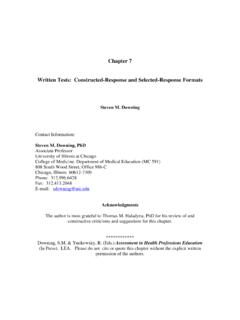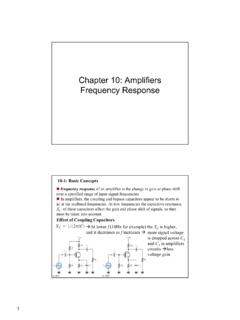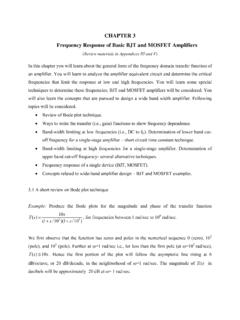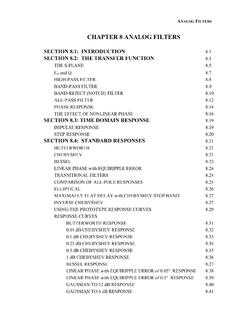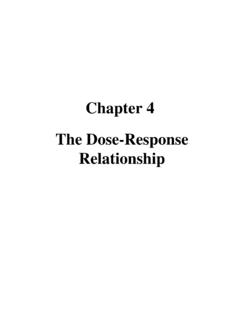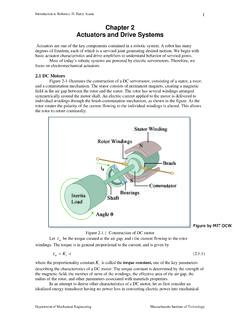Transcription of RESPONDING TO EMERGENCIES THE UK CENTRAL …
1 chapter 6, RESPONDING to an emergency: arrangements in England, was updated on 19 April 2013. RESPONDING TO EMERGENCIES THE UK CENTRAL government response CONCEPT OF OPERATIONS CONTENTS Page Introduction 4 Section 1: Emergency Management in the UK 5 The guiding principles of emergency response Phases of Emergency Management The role of the Devolved Administrations Levels of EMERGENCIES Section 2: The CENTRAL response Framework 11 Strategic Objectives Lead Responsibilities Role of the Lead government Department for response Role of the Lead government Department for Recovery Role of the Devolved Administrations Role of the Cabinet Office Overseas Territories Crown Dependencies Section 3 : The Role and Organisation of the Cabinet Office Briefing Rooms (COBR) COBR Senior Decision Making Body and supporting activity o Situational awareness o Intelligence Assessment o Operational response o Consequence Management o Recovery o Public information o Specialist Advice Triggers for Activating COBR Early Priorities Liaison between COBR and other partners Transition from response to Recovery Section 4: Planning Assumptions for the UK CENTRAL response Any Emergency o Specific arrangements for terrorist Incidents Support for local EMERGENCIES Continuity of UK CENTRAL government 21 44 Use of Emergency Powers Section 5: Local response and recovery to an Emergency in Great Britain 48 Strategic Co-ordinating Groups Three levels of Local response Section 6: RESPONDING to an Emergency.
2 Arrangements in England 51 Role of the Resilience and EMERGENCIES Division in an Emergency Multi-SCG response Co-ordinating Groups Recovery Arrangements Multi-RCG Recovery Co-ordinating Groups Arrangements in London Emergency Powers Section 7: Devolved Administrations 57 Reserved and devolved matters Relationship with UK CENTRAL government in an emergency Arrangements in Northern Ireland Arrangements in Scotland Arrangements in Wales Annexes: Annex A: The Civil Contingencies Act 2004 Annex B: Likely form of CENTRAL government engagement Annex C: Organisation of the CENTRAL response Annex D: The Provision of Scientific Advice Annex E: Overseas Territories Annex F: Crown Dependencies Annex G: Glossary INTRODUCTION 1. This document sets out arrangements for RESPONDING to and recovering from EMERGENCIES , irrespective of cause or location, requiring co-ordinated CENTRAL government action which could include direction, co-ordination, expertise, or specialised equipment and financial support.
3 It focuses primarily on the response to no-notice or short notice EMERGENCIES requiring UK CENTRAL government engagement although the principles, definitions and roles outlined here also underpin the more tailored approach that should be adopted to manage rising tide EMERGENCIES that develop more slowly. 2. The document describes how the CENTRAL government response will be organised, building on the role of the Lead government Department (LGD), along with the local arrangements which are the foundation of the response and recovery to any emergency in Great Britain and underpinned by the statutory framework for emergency preparedness set out by the Civil Contingencies Act 2004. It sets out the relationship between the CENTRAL , regional and local tiers within England, as well as covering the relationship between UK CENTRAL government and the devolved administrations in Scotland, Wales and Northern Ireland1.
4 3. The aim of this document is to outline the general framework and UK approach in RESPONDING to a disruptive challenge. It will also assist those involved in emergency planning within different organisations understand their own role and how it relates to the role of other individuals and organisations within government to produce an effective and co-ordinated response . 1 In this document all references to reserved issues or functions refer to those policy areas and functions which are reserved (in the case of Scotland and Northern Ireland) or are non-devolved (in the case of Wales) and are the responsibility of the UK government . The arrangements between the UK CENTRAL government and the Devolved Administrations in RESPONDING to EMERGENCIES are laid out in more detail in section 7 SECTION 1: EMERGENCY MANAGEMENT IN THE UK An emergency (or disruptive challenge) as defined in the Civil Contingencies Act 2004 is a situation or series of events that threatens or causes serious damage to human welfare, the environment or security in the United Kingdom.
5 This definition covers a wide range of scenarios including adverse weather, severe flooding, animal diseases, terrorist incidents and the impact of a disruption on essential services and critical infrastructure. More information on the Civil Contingencies Act 2004 can be found in Annex A. History has taught us to expect the unexpected. Events can, and do, take place that by their nature can not be anticipated exactly. response arrangements therefore need to be flexible in order to adapt to the circumstances at the time while applying good practice, including lessons from previous EMERGENCIES , and safeguarding the UK s constitutional settlement. The following guiding principles have been developed to capture the core characteristics of effective emergency response . They should be applied to the management of any emergency. These are: i.
6 Preparedness: All individuals and organisations that might have to respond to EMERGENCIES should be properly prepared, including having clarity of roles and responsibilities, specific and generic plans, and rehearsing response arrangements periodically. ii. Continuity: The response to EMERGENCIES should be grounded within organisations existing functions and their familiar ways of working although inevitably, actions will need to be carried out at greater speed, on a larger scale and in more testing circumstances during the response to an incident. iii. Subsidiarity: Decisions should be taken at the lowest appropriate level, with co-ordination at the highest necessary level. Local responders should be the building block of response for an emergency of any scale. iv. Direction: Clarity of purpose should be delivered through an awareness of the strategic aims and supporting objectives for the response .
7 These should be agreed and understood by all involved in managing the response to an incident in order to effectively prioritise and focus the response . v. Integration: Effective co-ordination should be exercised between and within organisations and local, regional and national tiers of a response as well as timely access to appropriate guidance and appropriate support for the local, regional or national level. vi. Communication: Good two-way communications are critical to an effective response . Reliable information must be passed correctly and without delay between those who need to know, including the public. vii. Co-operation: Positive engagement based on mutual trust and understanding will facilitate information-sharing and deliver effective solutions to arising issues. viii. Anticipation: In order to anticipate and manage the consequences of all kinds of EMERGENCIES , planners need to identify risks and develop an understanding of both the direct and indirect consequences in advance where possible.
8 Phases of Emergency Management Managing any emergency comprises three main phases: preparation (pre-planning); response (mitigating an immediate risk or stopping things getting worse); and recovery (a longer-term activity of rebuilding, restoring and rehabilitating the community). The response phase comprises two separate but closely-related and often overlapping challenges: crisis management and consequence (or impact) management. These are both designed to control and minimise the immediate challenges arising from an incident. Crisis management involves the phase of the response that attempts to prevent or avert an imminent emergency, along with the protective or other measures put in place to mitigate its effects, prevent further damage or disruption and secure the scene. It also includes actions taken to address the immediate effects of an incident and may include for example managing hostage situations, fighting fires, search and rescue, providing public health advice, evacuating those at risk and disseminating public information.
9 The duration of the crisis management phase can vary from a few hours or a few days in the case of an accident of explosion, or a few weeks or even months following an outbreak of a human or animal disease, until the situation is brought under control. Consequence management usually take place in parallel to crisis management and is concerned with steps taken to prevent the impact of an incident escalating. It includes managing wider consequences and services such as restoring transport networks or electricity supplies, managing community relationships, and providing shelter to displaced persons. Consequence management is also known as Impact Management'. The Recovery phase formally starts once the situation has been stabilised. However, preparation for the recovery phase should be an integral part of the emergency management process and should be considered alongside crisis and consequence management in the early stages of a response .
10 Recovery may be carried out at the local, regional, and/or national UK level, depending on the scale of the disaster. It can be defined as the process of rebuilding, restoring and rehabilitating the community following an emergency. In contrast to the response phase, the recovery process can take a considerable amount of time (months or years), as it seeks to support affected communities in the reconstruction of the physical infrastructure and restoration of emotional, social, economic and physical well-being. In some scenarios (eg wide-area flooding), it is likely that the recovery phase will have started in one area while crisis or consequence management activity continues in another. Levels of EMERGENCIES The local responders are the basic building block of the response to any emergency in the UK. EMERGENCIES (or major incidents) are routinely handled by the emergency services and other local responders without the need for any significant CENTRAL government involvement.












